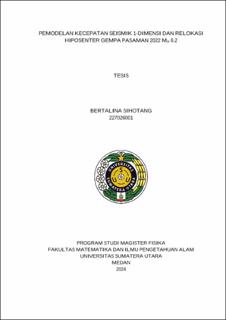| dc.contributor.advisor | Humaidi, Syahrul | |
| dc.contributor.advisor | Simanjuntak, Andrean Vesalius Hasiholan | |
| dc.contributor.author | Sihotang, Bertalina | |
| dc.date.accessioned | 2024-10-29T06:47:46Z | |
| dc.date.available | 2024-10-29T06:47:46Z | |
| dc.date.issued | 2024 | |
| dc.identifier.uri | https://repositori.usu.ac.id/handle/123456789/98411 | |
| dc.description.abstract | The island of Sumatera has a complex tectonic system with the Sumatera fault and subduction zone due to the convergence of the Indo-Australian and Eurasian plates. The Sumatera fault, along ±1,650 km, and the active subduction zone often trigger destructive earthquakes, such as the 6.2 magnitude Pasaman earthquake on February 25, 2022, which caused 27 casualties and destroyed thousands of houses. This research aims to model the seismotectonic structure of the West Sumatera region through hypocenter relocation using a 1-Dimensional seismic velocity model and the double-difference method. Seismicity data from BMKG during the Pasaman earthquake and its aftershocks are used for this analysis. The relocation process involves the Velest program for the velocity model and HypoDD for hypocenter clustering. An appropriate velocity model will accurately depict the hypocenter distribution and aid in the interpretation of local tectonic structures. The statistical analysis results show that the Pasaman earthquake formed earthquake clusters related to previously unidentified local active faults, which are then named the Kajai fault. Moment tensor inversion provides information about the earthquake source mechanism with a dominant double-couple component. In addition to identifying the fault, this study also produces a new 1-D velocity model with an rms value < 1.0, low a and b values indicating high rock stress, and the Magnitude Completeness value at the M 2.8 boundary. This research provides a better understanding of seismic activity and disaster potential in the West Sumatera region, as well as important information for future earthquake mitigation. | en_US |
| dc.language.iso | id | en_US |
| dc.publisher | Universitas Sumatera Utara | en_US |
| dc.subject | Coupled Velocity-Hypocenter (CVH) | en_US |
| dc.subject | HypoDD | en_US |
| dc.subject | 1-Dimensional seismic velocity model | en_US |
| dc.subject | Model kecepatan seismik 1-Dimensi | en_US |
| dc.subject | Hypocenter relocation | en_US |
| dc.subject | Sumatera Fault System | en_US |
| dc.title | Pemodelan Kecepatan Seismik 1-Dimensi dan Relokasi Hiposenter Gempa Pasaman 2022 Mw 6.2 | en_US |
| dc.title.alternative | 1-Dimensional Seismic Velocity Modelling and Hypocenter Relocation of the 2022 Mw 6.2 Pasaman Earthquake | en_US |
| dc.type | Thesis | en_US |
| dc.identifier.nim | NIM227026001 | |
| dc.identifier.nidn | NIDN0017066501 | |
| dc.identifier.kodeprodi | KODEPRODI45101#Fisika | |
| dc.description.pages | 64 Pages | en_US |
| dc.description.type | Tesis Magister | en_US |
| dc.subject.sdgs | SDGs 9. Industry Innovation And Infrastructure | en_US |


